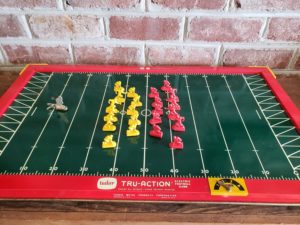
Picture the concept: You put eleven players into position. Your opponent does the same. You flip an inline-cord switch. The field begins vibrating. After the players move a bit on their tremor-plagued gridiron, you stop the game. You then place a felt “ball” on the base of a player, and turn the game back on. Your player has an opening! He rumbles through . . . wait! He’s turning around! He’s running the wrong way!
Hit the switch. You have just witnessed a very common scene in 1960’s electric football. Your player turned the wrong way.
Anticipating this, the rule book mercifully calls the play dead, rather than have your running back relive Jim Marshall’s 1964 run against San Francisco.
Despite its unpredictability and potential for electric shock, Tudor electric football games were a thrill to kids everywhere.
I remember getting mine in 1971, with the players painted like Kansas City and Minnesota. It was such a trip taking the game out of the box, setting up the goalposts and surrounding crowded stands, and organizing your teams.
There was, of course, a player who stood head and shoulders above the rest: the ubiquitous quarterback-kicker.
This player was able to heave long bombs of six inches or more. And there was a chance, albeit a microscopic one, of a player actually being hit by the felt projectile, thereby making the pass complete! Of course, if it hit a defender, bad news.
Field goals were much more common. You could put one through the uprights 80 yards away. No word on whether there were steroids tests done on the limber-legged kickers.
And the game was great training for life. When we became parents, and did our best to raise our kids the right way, it wasn’t uncommon to see them, against all common sense, turn around and run the wrong way.
Unfortunately, they didn’t always stop when we went for the off switch.